What is Caesarean Section (C Section)
You may need a C-section if you have certain medical conditions or if complications occur during labor in a vaginal delivery. A planned C-section happens when any of the following conditions exist:
- Cephalopelvic disproportion (CPD): CPD is a term that means that your baby's head or body is too large to pass safely through your pelvis, or your pelvis is too small to deliver an average-sized baby.
- Previous C-section: Although it’s possible to have a vaginal birth after a previous C-section, it’s not an option for everyone. Factors that can affect this include type of uterine incision used in the previous C-section and the risk of uterine rupture.
- Expecting multiples: Although twins can often be delivered vaginally, two or more babies might require a C-section.
- Placenta previa: In this condition, the placenta is attached too low in your uterus and blocks your baby's exit through your cervix.
- Transverse lie: The baby is in a horizontal, or sideways, position in your uterus.
- Breech presentation: In a breech presentation, your baby's feet- or bottom-first in your uterus. Some providers may attempt to turn your baby, but a C-section will be necessary if that's unsuccessful.
- Obstruction: A large uterine fibroid, a pelvic fracture or you're expecting a baby with certain congenital anomalies may also be reasons for a C-section.
Benefits of Normal Delivery
- Avoids risks associated with instruments used for a c-section delivery.
- Lower risk of infection for mother and child.
- Quicker recovery for mother and shorter hospital stay (24-48 hours as compared to 3 days to a week post caesarean).
- The natural bacteria and microbes of the vagina transferred from mother to child boost the baby’s immune system, readying it for life outside the protected womb.
- Babies are at lower risk for respiratory problems since the labour contractions help prepare the baby’s lungs for breathing
- Normal delivery stimulates lactation because the birthing process activates numerous natural mothering hormones.




